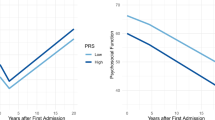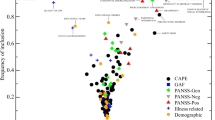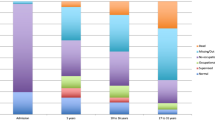Summary
In a 5 year follow-up study of 81 patients suffering from schizophrenic or similar psychoses many of the predictors known from the literature concerning the outcome of schizophrenia were confirmed. In accordance with the results of the follow-up study on patients from the International Pilot Study of Schizophrenia (IPSS), long lasting professional disintegration and psychiatric hospitalisation preceding index-admission were of special prognostic importance. However in contrast to this follow-up study, other psychopathological data, especially minus symptoms proved to be of considerable prognostic significance. As a result of stepwise multiple regression analyses, combinations of the 5 best characteristics for each outcome-criterion have been found which explain a significantly greater part of the variance than single characteristics.
Zusammenfassung
In einer 5-Jahres-Katamnese an 81 Patienten mit schizophrenen oder ähnlichen paranoiden Psychosen konnten viele aus der Katamneseliteratur bekannte Prädiktoren bestätigt werden. Langdauernde berufliche Desintegration und psychiatrische Hospitalisierung vor Index-Aufnahme erwiesen sich, wie in den follow-up-Untersuchungen der Patienten der International Pilot Study of Schizophrenia (IPSS), als prognostisch besonders relevante Merkmale. Im Gegensatz zur follow-up der IPSS-Patienten, zeigt sich aber auch eine erhebliche prognostische Bedeutung psychopathologischer Merkmale insbesondere von Minussymptomatik. Durch schrittweise multiple Regressionsanalyse wurden für jedes „outcome“-Kriterium Kombinationen von 5 besten Prädiktoren ermittelt, die einen wesentlich größeren Varianzanteil erklärten, als einzelne Prädiktoren.
Similar content being viewed by others
Literatur
Achté, KA (1967) Verlauf und Prognose schizophrener Psychosen in Helsinki. In: Schimmelpenning GW (Hrsg) Psychiatrische Verlaufsforschung. Methoden und Ergebnisse. Huber, Bern Stuttgart Wien
Affleck JW, Burns J, Forrest AD (1976) Long term follow-up of schizophrenic patients in Edinburgh. Acta Psychiatr Scand 53:227–237
Astrachan BM, Brauer L, Harrow M, Schwartz C (1974) Symptomatic outcome in schizophrenia. Arch Gen Psychiatr 31:37–42
Astrup C (1975) Long-term prognosis of the functional psychoses. In: Mitsuda H, Fukuda T (eds) Biological mechanism of schizophrenia and schizophrenia-like psychoses. Thieme, Stuttgart
Barthelmes H, Zerssen D v (1978) Das Münchner Psychiatrische Informationssystem (PSYCHIS München). In: Reichartz PL, Schwarz B (Hrsg) Informationssysteme in der medizinischen Versorgung. Schattauer, Stuttgart New York
Bleuler M (1972) Die schizophrenen Geistesstörungen im Lichte langjähriger Kranken- und Familiengeschichten. Thieme, Stuttgart
Brown GW, Bone M, Dalison B, Wing JK (1966) Schizophrenia and social care. Oxford University Press, London
Ciompi L, Müller C (1976) Lebensweg und Alter der Schizophrenen. Eine katamnestische Langzeitstudie bis ins Senium. Monographien aus dem Gesamtgebiete der Psachiatrie, Bd 12. Springer, Berlin Heidelberg New York
Ellendorf C (1975) Studie zur Validierung der diagnostischen Sichtlochkartenkartei (DiaSiKa). Med Diss München
Goldberg SC, Schooler NR, Hogarty GE, Roper M (1977) Prediction of relapse in schizophrenic outpatients treated by drug and sociotherapy. Arch Gen Psychiatr 34:171–184
Hargreaves WA, Glick ID, Drues J, Showstack JA, Feigenbaum E (1977) Short vs. long hospitalization: VI. Two-year follow-up results for schizophrenics. Arch Gen Psychiatr 34:305–311
Hinterhuber H (1973) Zur Katamnese der Schizophrenien. Eine klinisch-statistische Untersuchung lebenslanger Verläufe. Fortschr Neurol Psychiatr 41:527–558
Hope K (1968) Methods of multivariate analysis. University of London Press, London
Huber G, Gross G, Schüttler R (1979) Schizophrenie. Eine Verlaufs- und psychiatrische Langzeitstudie. Springer, Berlin Heidelberg New York
Keniston K, Boltax S, Almond R (1971) Multiple criteria of treatment outcome. J Psychiatr Res 8:107–108
Langfeldt G (1956) The prognosis of schizophrenia. Acta Psychiatr Neurol Scand [Suppl] 110
Lo W, Lo T (1977) A ten-year follow-up study of Chinese schizophrenics in Hong Kong. Br J Psychiatr 131:63–66
Lorr M (1974) Assessing psychotic behavior by the IMPS. In: Pichot P, Olivier-Martin R (eds) Psychological measurements in psychopharmacology. Modern problems in pharmacopsychiatry, vol 7. Karger, Basel
Lorr M, Klett CJ (1967) Manual for the inpatient psychiatric scale (rev.). Consulting Psychologists Press, Palo Alto/California
Mintz J, O'Brien ChP, Luborsky L (1976) Predicting the outcome of psychotherapy for schizophrenics. Arch Gen Psychiatr 533:1183–1187
Möller HJ, v Zerssen D, Werner-Eilert K, Wüschner-Stockheim M (1981a) Psychopathometrische Verlaufsuntersuchungen an Patienten mit Schizophrenien und verwandten Psychosen. Arch Psychiatr Nervenkr 230:275–292
Möller HJ, v Zerssen D, Wüschner-Stockheim M, Werner-Eilert K (1981b) Die prognostische Bedeutung psychopathometrischer Aufnahme- und Entlassungsbefunddaten schizophrener Patienten. Arch Psychiatr Nervenkr 231:13–34
Möller HJ, Werner-Eilert K, Wüschner-Stockheim M, v Zerssen D (1981c) Psychopathologische Störungen und Beeinträchtigungen der sozialen Adaptation bei Patienten mit Schizophrenien und verwandten Psychosen 5 Jahre nach Klinikentlassung. Beziehungen zwischen den Katamnesedaten. In: Beckmann H (Hrsg) Kongreßbericht des 1. Symposions der Deutschen Gesellschaft für biologische Psychiatrie. Karger, Basel (im Druck)
Nie NH, Hull CH, Jenkins JG, Steinbrenner K, Bent DH (1975) Statistical package for the social sciences. 2nd edn. McGraw-Hill, New York, St Louis San Francisco
Philips L (1966) Social competence, the process-reactive distinction, and the nature of mental disorder. In: Hoch PH, Zubin J (eds) Psychopathology of schizophrenia. Grune and Stratton, New York
Pokorny AD, Thornby J, Kaplan HW, Ball D (1976) Prediction of chronicity in psychiatric patients. Arch Gen Psychiatr 33:932–937
Renton CA, Affleck JW, Carstairs GM, Forrest AD (1963) A follow-up of schizophrenic patients in Edinburgh. Acta Psychiatr Scand 39:548–581
Rosen B, Klein DF, Gittelman-Klein R (1971) The prediction of rehospitalization: The relationship between age of first psychiatric treatment contact, marital status and premorbid social adjustment. J Nerv Ment Dis 152:17–22
Spitzer J, Endicott RL, Fleiss L (1976) The global assessment scale. A procedure for measuring overall severity of psychiatric disturbances. Arch Gen Psychiatr 33:766–771
Stephens JH (1970) Long-term course and prognosis in schizophrenia. Sem Psychiatr 2:464–485
Strauss JS, Carpenter WT (1972) The prediction of outcome in schizophrenia. I. Characteristics of outcome. Arch Gen Psychiatr 27:739–746
Strauss JS, Carpenter WT (1974) The prediction of outcome in schizophrenia. II. Relationship between predictor and outcome variables. Arch Gen Psychiatr 31:37–42
Strauss JS, Carpenter WT (1977) The prediction of outcome in schiziphrenia: III. 5-year outcome and its predictors. Arch Gen Psychiatr 34 159–163
Vaillant G (1962) The prediction of recovery in schizophrenia. J Nerv Ment Dis 135:534–543
Watts FN, Bennett DH (1977) Previous occupational stability as a predictor of employment after psychiatric rehabilitation. Psychol Med 7:709–717
Wechsler D (1964) Die Messung der Intelligenz Erwachsener. Huber, Bern Stuttgart
World Health Organization (1973) The international Pilot study of schizophrenia. WHO, Genf
World Health Organisation (1979) Schizophrenia. An international follow-up study. Wiley, Chichester New York Brisbane Toronto
Zerssen D v, Cording C (1978) The measurement of change in endogenous affective disorders. Arch Psychiatr Nervenkr 226:95–112
Zerssen D v (1982) Die Diagnostische Sichtlochkartei (DiaSiKa) — ein einfaches Instrument zur Standardisierung der psychiatrischen Diagnostik (in Vorbereitung)
Author information
Authors and Affiliations
Rights and permissions
About this article
Cite this article
Möller, H.J., Werner-Eilert, K., Wüschner-Stockheim, M. et al. Relevante Merkmale für die 5-Jahres-Prognose von Patienten mit schizophrenen und verwandten paranoiden Psychosen. Arch Psychiatr Nervenkr 231, 305–322 (1982). https://doi.org/10.1007/BF00345587
Received:
Issue Date:
DOI: https://doi.org/10.1007/BF00345587




